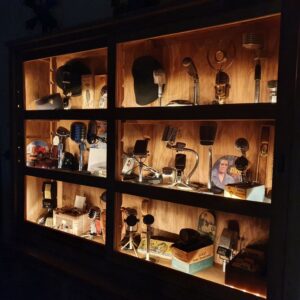


“Echoes of the Past: The Art and Joy of Collecting Vintage Microphones”
Introduction: In the ever-evolving landscape of audio technology, vintage microphones stand as nostalgic ambassadors of a bygone era, each possessing a unique character and a story to tell. Collecting these audio relics has become a passionate pursuit for enthusiasts who appreciate the craftsmanship, history, and the unmistakable warmth that vintage microphones bring to sound recording. In this article, we’ll explore the allure of collecting vintage microphones and why they continue to captivate audio aficionados worldwide.
-
The Beauty of Vintage Craftsmanship: Vintage microphones are more than just functional tools; they are exquisite pieces of craftsmanship. From the intricate designs to the high-quality materials used, each microphone tells a tale of the dedication and artistry that went into its creation. Exploring the details of these timeless artifacts becomes a journey into the history of audio engineering.
-
A Sonic Time Capsule: Every vintage microphone carries the essence of the time it was created. The unique tonal characteristics, colorations, and imperfections contribute to the distinctive sound signatures that are highly sought after by collectors. Owning a collection of vintage microphones allows enthusiasts to transport their recordings back in time, capturing the sonic nuances of different eras.
-
Hunting for Hidden Gems: The thrill of the hunt is an integral part of collecting vintage microphones. Whether scouring flea markets, attending auctions, or connecting with fellow collectors, the search for rare and unique pieces becomes an adventure. Unearthing a hidden gem, perhaps a microphone used by a famous artist or in a historic recording, adds an extra layer of excitement to the collector’s journey.
-
Preserving Audio History: Collectors of vintage microphones play a vital role in preserving audio history. Each microphone represents a technological milestone and contributes to the broader narrative of how sound recording has evolved over time. By maintaining and showcasing these pieces, collectors become custodians of a valuable cultural heritage.
-
Restoration and Maintenance: Owning vintage microphones often involves the art of restoration. Collectors with a passion for DIY projects find joy in bringing old microphones back to life, ensuring they function as intended while preserving their authentic character. The process of restoration adds a personal touch to the collection and enhances the appreciation for the engineering feats of the past.
-
Connecting with a Community: Collecting vintage microphones is not a solitary pursuit. Enthusiasts often form a close-knit community, sharing knowledge, experiences, and tips on finding rare pieces. Whether through online forums, local meet-ups, or specialized events, collectors can bond over their shared love for vintage audio equipment.
Conclusion: In the world of sound, vintage microphones stand as timeless treasures, offering collectors a chance to connect with the rich history of audio recording. From the thrill of the hunt to the satisfaction of restoring and showcasing these gems, the art of collecting vintage microphones is a celebration of craftsmanship, technology, and the enduring magic of analog sound.
Art Deco

Art Deco microphones are a captivating fusion of elegance, geometric precision, and technological innovation, reflecting the distinctive design principles of the Art Deco movement that flourished in the early to mid-20th century. Here are some key characteristics that describe Art Deco microphones:
-
Geometric Symmetry: Art Deco microphones often feature strong geometric shapes, characterized by symmetrical lines and bold, angular patterns. The design is marked by a sense of balance and order, reflecting the movement’s emphasis on precision and modernity.
-
Streamlined Forms: Embracing the streamlined aesthetic of the era, Art Deco microphones boast sleek and aerodynamic shapes. Smooth curves and tapered lines contribute to a sense of dynamism, creating a visually appealing and forward-looking design.
-
Luxurious Materials: Art Deco microphones are crafted from luxurious materials that emphasize both opulence and sophistication. Chrome, polished metals, and lacquered finishes are commonly used, contributing to a sense of glamour and modern luxury.
-
Ornate Details: Despite the focus on simplicity and functionality, Art Deco microphones often incorporate intricate details. Delicate patterns, engraved motifs, and decorative elements showcase a meticulous attention to design, turning each microphone into a small work of art.
-
Contrasting Colors: The color palette of Art Deco microphones is characterized by bold contrasts. Black, silver, gold, and vibrant colors like deep red or royal blue are frequently used to create visually striking combinations that enhance the overall aesthetic appeal.
-
Innovative Grille Designs: The microphone grilles in Art Deco designs are notable for their creative and often asymmetrical patterns. Intricate grille designs not only serve a functional purpose but also contribute to the microphone’s overall visual interest.
-
Futuristic Influence: Art Deco emerged during a period of rapid technological advancement, and this influence is evident in the futuristic design elements of Art Deco microphones. The streamlined forms and polished surfaces evoke a sense of progress and modernity.
-
Inspired by Nature: Some Art Deco microphones draw inspiration from natural forms. While maintaining a streamlined and modern appearance, these designs may incorporate stylized botanical or animal motifs, bringing a touch of nature into the technological realm.
-
Compact and Portable: Many Art Deco microphones were designed with portability in mind. Compact and lightweight, these microphones reflected the changing lifestyles of the era, where mobility and convenience were increasingly important.
-
Iconic Branding: Art Deco microphones from well-known manufacturers often feature iconic branding elements integrated into the overall design. Logos and brand names are seamlessly incorporated, becoming part of the visual identity of the microphone.
In summary, Art Deco microphones are a testament to the marriage of art and technology, embodying the spirit of an era that celebrated modernity, luxury, and innovative design. The meticulous craftsmanship and aesthetic flair of these microphones make them not only functional audio devices but also timeless artifacts of a unique and influential design movement.

Streamline design
Design movement and style from the 1930s-1950s, originating from the United States.
Streamlined microphones refer to a specific design approach characterized by smooth, flowing lines, and aerodynamic shapes that minimize resistance and create a sense of motion. The streamlined design aesthetic emerged in the early to mid-20th century, particularly during the Art Deco and Streamline Moderne movements. This design philosophy sought to embody the ideals of modernity, efficiency, and progress.
Key features of streamlined microphones include:
-
Smooth Contours: Streamlined microphones are distinguished by their sleek and uninterrupted curves. The design avoids sharp angles, favoring gentle, flowing lines that contribute to a sense of continuity and harmony.
-
Aerodynamic Shapes: Inspired by the principles of aerodynamics, streamlined microphones often have shapes reminiscent of aircraft or other streamlined objects. These shapes aim to reduce air resistance, conveying a sense of efficiency and speed.
-
Minimalist Details: The streamlined design often involves a reduction of decorative elements. Ornate embellishments are replaced by clean, uncluttered surfaces, emphasizing simplicity and functionality.
-
Integration of Form and Function: Streamlined microphones are designed not only to look visually appealing but also to enhance functionality. The form of the microphone is integrated with its intended purpose, creating a harmonious balance between aesthetics and practicality.
-
Use of Modern Materials: Streamlined microphones typically incorporate modern materials, such as chrome, aluminum, and other polished metals. These materials not only contribute to a shiny and reflective surface but also align with the contemporary and futuristic ideals of the eras in which these microphones were popular.
-
Emphasis on Symmetry: While not strictly adhering to symmetrical designs, streamlined microphones often display a balanced and symmetrical arrangement of components. This contributes to a sense of order and elegance in the overall design.
-
Compact and Portable: The streamlined design often lends itself to compact and portable forms. This was especially relevant during periods when mobility and convenience became increasingly important in consumer products.
-
Futuristic Influence: Streamlined microphones are influenced by the futuristic visions of their time. The design elements convey a sense of progress and innovation, reflecting the optimism and enthusiasm for technological advancements during the early to mid-20th century.
Overall, streamlined microphones are a visual representation of the desire for efficiency, progress, and a forward-looking aesthetic. This design philosophy has left an enduring impact, with streamlined elements continuing to influence product design across various industries to this day.
.